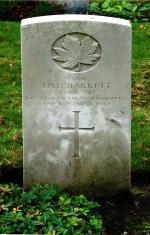John Henry Desmond Barrett was born St Alban’s, England to Canadian parents during the Great War. His parents returned to Canada when he was only six months old and he grew up in Victoria, British Columbia. He graduated from the Royal Military College (Number 2207) in 1935 and served in the Non-Permanent Active Militia for the next four years. He graduated with a Batchelor of Arts (Science) degree from the University of British Columbia in 1939.
On 2 December 1939, he married Rosalie Ethel Moore, a well-known pilot, member of the all-female 'Flying Seven', and second woman in Canada to earn a commercial flying license. In December 1939 and volunteered for active service a few days later. John remained in Victoria until the following September when he was transferred to the 3rd Canadian Infantry Division Engineers and posted overseas to England, attached to the 2nd Canadian Pioneer Company. After a short time on the Engineer Holding List, he was transferred to the 3rd Field Company. His wife remained in Canada and a son was born in March 1941. A few months later, Rosalie opened a flying school in hopes of having women enlist in the Air Force.
On 17 August 1940, 3rd Field Company embarked for for Spitzbergen on Operation GAUNTLET landing on 25 August. The goal of the operation, which had the approval of the Norwegian and Soviet governments, was to evacuate the civilian population and deny Germany the coal, mining and shipping infrastructure, equipment and stores, and suppress any wireless stations on the archipelago to prevent the Germans receiving weather reports. The force returned to England in early September. John was attached to an artillery unit for a short time to learn antitank tactics. In February 1942, John returned to Vancouver for leave and then to Kingston, Ontario for staff training at RMC. He returned to England in July to take a staff officer position at First Canadian Army HQ. In October, he was appointed Chief Instructor at the Canadian Engineer Reinforcement Unit.
In April 1944, John took command of the 11th (Lampton) Field Company. The 11th Field Company arrived in France on 7 July as part of 2nd Canadian Division Engineers. John led them through all the operations during the Battle of Normandy, the advance across the Seine, through the Channel Ports and into Belgium, clearing routes and building bridges.
John's company was responsible for some of the first bridges across the Antwerp-Turnhout Canal in the opening days of the Battle of the Scheldt. Later, they helped in clearing the Beveland approaches. Throughout the Battle of the Scheldt, they followed and led the advance and in the closing days of the battle were instrumental in ceasing and securing the bridgehead over the South Beveland Canal. In these months of command, John impressed his superiors as was reflected in his first performance report where he was described as ‘an excellent company commander with more than average knowledge of his job. Lots of common sense and a good leader. Likely to become a CRE. Recommended for Senior Officers School.”
The details surrounding John’s death are clouded. The unit’s war diary reports at 1900 hours on 31 October, John, a lieutenant, and two sappers left to visit the 2nd Field Company to pick up a new jeep that had been delivered there by mistake. The War Diary of the 2nd Field Company confirms the visit as well as a meeting between John and the newly arrived OC, Major Nelson. It further mentions that both Majors Nelson and Barrett decided to see “how things were on the causeway after dark”. Their new jeep collided with a half-track at a roadblock and was destroyed. Both majors were evacuated and the War Diary reports neither was seriously hurt. There is no mention of any of the accident in either the 11th Field Company’s War Diary nor Major Barrett’s personal file.
The two sappers returned to the 11th Field Company at midnight, but without John and Lt Street. John had still not returned the following morning and at 1300 hours, an officer was sent out to find him. Meanwhile, Maj Nelson was also missing. The 11th Field Company found John at 1430 hours at Number 2 Canadian Clearing Station with a crushed right chest, cuts and bruises, and a broken nose, but “out of danger”. Medical records say he was breathing and awake, his speech was incoherent and his breathing laboured. He was unable to explain how he was injured, which was attributed to a concussion..
The following day, on 2 November, the CRE visited the 2nd Feild Company. Neither of the two majors was present and their whereabouts were unknown to the CRE’s staff. As the company was in the midst of “the fastest and worst move in unit history”, the confusion was somewhat justified and other members of the company were also unreachable. The CRE was later informed that John had been found at the clearing station, “not in very good condition”. Major Nelson was still missing.
Major John Barrett died on 2 November 1944, most likely from a cerebral haemorrhage. He is buried in Schoonselhof Cemetery. He was 30 years old. He left a small son in Victoria. His wife Rolalie, continue as an aviation pioneer.
Return to Part 5: Tributes to the Fallen Sappers of the Scheldt

